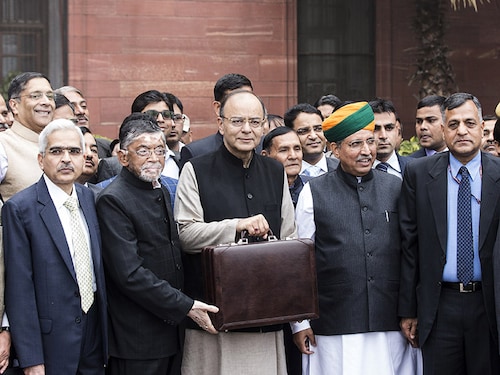FM makes the right moves: Will the economy respond with a higher pace of growth?
The finance minister must be hoping that his measures help power the economy by restoring consumption which took a beating during demonetisation


Image: Udit Kulshrestha/Bloomberg via Getty Images
Arun Jaitley was expected to boost consumption by leaving more money in the hands of the people. He did just that. The income tax rates for people earning between Rs 2.5 lakh and Rs 5 lakh per annum has been halved from 10 percent to 5 percent. This would mean that there will be zero tax liability for people getting income of up to Rs 3 lakh per annum and the tax liability will only be Rs 2,500 for people with income between Rs 3 lakh and Rs 3.5 lakh. If the limit of Rs 1.5 lakh under Section 80C for investment is used fully, the tax would be zero for people with income of Rs 4.5 lakh. Taxpayers in subsequent slabs will also get a uniform benefit of Rs 12,500 per person. As Jaitley mentioned in the Union Budget, taxpayers form a small part of the overall population. He has thus chosen to leave more money in the hands of the rural poor by enhancing the allocation to MGNREGA scheme from Rs 38,500 crore last year to Rs 48,000 crore – the highest allocation ever. It is expected that people will use this money to spend and thereby increase consumption. It is critical for this to happen as private investment – a critical engine of growth – has been languishing for a while now mostly on account of excess capacity in the system. Higher consumption will hopefully absorb this excess capacity and get the sector to start investing again.
The finance minister was also expected to spend a lot in a bid to kick-start the investment cycle. He has not disappointed there too. Total rural spending that he has budgeted is Rs 1.87 lakh crore – 24 percent higher than last year. He is also spending Rs 2.41 lakh crore on roads, railways and shipping. The overall spending when it comes to infrastructure is estimated at Rs 3.96 lakh crore. Of the total government expenditure of Rs 21.47 lakh crore in 2017-18, he has ensured that capital expenditure grew by 25 percent. “This magnitude of investment will spur a huge amount of economic activity across the country and create more jobs,” he said in his speech.
As expected, he also chose to delay the pace of fiscal consolidation. Instead of reaching a fiscal deficit target of 3 percent of GDP in 2017-18, he will now reach 3.2 percent and use the funds thus freed to spend. By choosing a figure of 3.2 percent, he has ensured that markets and rating agencies do not get jittery. By doing so, he has not only created more space for spending but also not lost sight of the fiscal consolidation. He has said that he will reach the 3 percent level next year.
Jaitley was expected to expand the formal economy and take on black money as a step in continuation of demonetisation. He has done that by pushing digital payments, tightening limits on cash payments (he has reduced cash payments that can be claimed as expenditure to Rs 10,000, restricted maximum cash payment to Rs 3 lakh and taken a bold step in tackling electoral funding. On the corporate tax front, it was expected that he will continue the move towards the 25 percent tax rate. Here too, he delivered by reducing the tax rate of MSMEs with turnover below Rs 50 crore to 25 percent. This move, though, has left larger corporate a tad disappointed.
The minister will now hope that his measures help power the economy by restoring consumption which took a beating during demonetisation. Robust consumption, higher public investment should help revive the private investment cycle and if that happens, Indian economy will be on a faster pace of growth.
First Published: Feb 01, 2017, 20:30
Subscribe Now